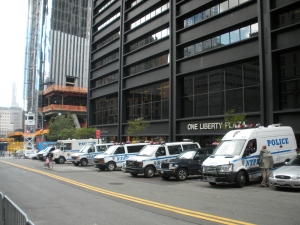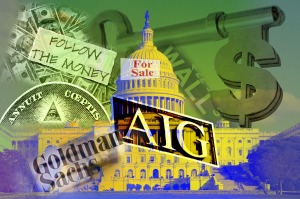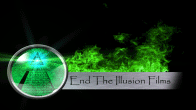A Tale of 3 Cities
Washington DC
Early in the month of October, I visited the October 2011 occupation of Freedom Plaza in Washington DC. In this plaza I found thousands of people who had gathered for many different reasons, but I could distill the reasons to the following: wealth inequality and its associated greed, corruption of money in the political process, and the endless wars being fought by our nation. The levels of frustration among the American people have been growing and this event was taking place at approximately the same time as the Occupy Wall Street movement.
 During this time, I attended several mass marches to various destinations within Washington DC. One thing that impressed me was the professionalism and cooperation that the Washington DC police provided during these marches. The DC police were extremely effective in making the marches move efficiently. They would temporarily block side streets to let the marchers pass and then quickly reopen them. The marchers were directed to stay on one side of the road and the DC police made sure that traffic flowed smoothly on the other side. The relationship between the protestors and the police was one of cordiality and politeness. The numbers of arrests were extremely small, and order was maintained efficiently.
During this time, I attended several mass marches to various destinations within Washington DC. One thing that impressed me was the professionalism and cooperation that the Washington DC police provided during these marches. The DC police were extremely effective in making the marches move efficiently. They would temporarily block side streets to let the marchers pass and then quickly reopen them. The marchers were directed to stay on one side of the road and the DC police made sure that traffic flowed smoothly on the other side. The relationship between the protestors and the police was one of cordiality and politeness. The numbers of arrests were extremely small, and order was maintained efficiently.
New York
Later in the month, I visited Zucotti Park where the epicenter of the Occupy Wall St movement is camped out. Here I found a totally different environment. The authorities seemed to want an adversarial relationship with the protestors and had ordered the police to place barricades everywhere so that protestors were always trapped in large numbers in very small areas. The overriding priority seemed to be to keep all streets open at any cost. This meant the NYPD needed large numbers of police to man the barricades, in fact many times police were lined up man to man next to each other the entire length of the barricades which could be blocks in length.
 Due to the trapping effect of these barricades, it was often impossible to move because there were so many people in front or behind you. I personally witnessed people being arrested because they physically could not move. This trapping effect also created congestion on the sidewalks that often spilled out into the streets. While many of the police acted professionally, the general demeanor of some was very confrontational. The results are that there have been thousands of arrests and thousands of police needed to maintain an extremely inefficient barricading system. Another result is that the confrontational attitude exhibited by some of the police made sustaining order much more difficult. The countless videos available for viewing on the Internet have established a pattern of peaceful protestors facing aggressive police, reminiscent of the Arab regime police responses to their protestors. The level of order in NYC was significantly lower than that of Washington DC. This large use of manpower certainly added to the costs of maintaining that order.
Due to the trapping effect of these barricades, it was often impossible to move because there were so many people in front or behind you. I personally witnessed people being arrested because they physically could not move. This trapping effect also created congestion on the sidewalks that often spilled out into the streets. While many of the police acted professionally, the general demeanor of some was very confrontational. The results are that there have been thousands of arrests and thousands of police needed to maintain an extremely inefficient barricading system. Another result is that the confrontational attitude exhibited by some of the police made sustaining order much more difficult. The countless videos available for viewing on the Internet have established a pattern of peaceful protestors facing aggressive police, reminiscent of the Arab regime police responses to their protestors. The level of order in NYC was significantly lower than that of Washington DC. This large use of manpower certainly added to the costs of maintaining that order.
Philadelphia
Since Philadelphia is very close to my residence, I also made a brief visit to the Occupy Philly site. My time at this site was the shortest of the 3 cities. In Philadelphia, the city officials have taken a more enlightened approach and allowed the protestors to camp next to City Hall. The protestors were warned not to block traffic, keep the area clean, and to not break any laws. This enlightened approach has resulted in a minimal number of arrests and the efficient use of police manpower. The numbers of police required to keep order in Philadelphia, is a very small fraction of what New York is utilizing. I did not attend any marches, so I cannot speak to how they went.
In Summary
Washington DC and Philadelphia have taken a cooperative approach with the protestors. This has resulted in low arrest numbers and significantly smaller manpower requirements. In Washington DC, the marches flowed much more smoothly with less interference with traffic flow, and a higher level of order.
NYPD Response to Occupy Wall St from Illusionist on Vimeo.
In contrast, New York has taken a confrontational approach with the protestors and this has reduced the level of order, interfered with traffic flow, and required huge numbers of police to maintain a very inefficient control system. It has also resulted in large numbers of arrests, and  subsequent clogging of the court system. The number of civil cases that will inevitably result from this confrontational approach will also burden the court system in the future. This confrontational approach has also encouraged rogue members of the NYPD to act outside of the law and in unprofessional ways, which leaves the city open to potential costly lawsuits. Many of these acts have been video recorded and will make defending the rogue actions problematic. This confrontational approach also removes large numbers of police from doing real investigative and police work. It is difficult to determine whether these poorly thought out decisions were made by city officials or the police leadership. However, the end result has been significant costs to the taxpayers in NYC and a reduced level of order. The NYPD is has also taken a public relations hit worldwide. This is unfortunate after the positive perceptions that were developed after 9-11. It is small wonder that the city requires a Civilian Review Board to handle complaints against the police.
subsequent clogging of the court system. The number of civil cases that will inevitably result from this confrontational approach will also burden the court system in the future. This confrontational approach has also encouraged rogue members of the NYPD to act outside of the law and in unprofessional ways, which leaves the city open to potential costly lawsuits. Many of these acts have been video recorded and will make defending the rogue actions problematic. This confrontational approach also removes large numbers of police from doing real investigative and police work. It is difficult to determine whether these poorly thought out decisions were made by city officials or the police leadership. However, the end result has been significant costs to the taxpayers in NYC and a reduced level of order. The NYPD is has also taken a public relations hit worldwide. This is unfortunate after the positive perceptions that were developed after 9-11. It is small wonder that the city requires a Civilian Review Board to handle complaints against the police.
I would strongly suggest that the police leadership in the NYPD attend some workshops on crowd control presented by the Washington DC police. The contrasts between these two police forces is enormous and NYPD leadership certainly needs some basic training in this area.
Leave a comment Cancel reply
Thomas Jefferson
Recent Posts
- Community Part 1
- “Illusions Will Fall” ethereal rock opera songs compilation
- Enchantment Begins
- Avizius – Into Other Realms
- This is the “Quiet Time”, Choose Wisely
- Harley Shovelhead Exhaust Leak Solution
- Once We Awaken
- Time To Eliminate Your Wall Street Tax?
- Journeys
- Break Out of the Illusion
- Highwaymen Motorcycle Club – Highwaymen MC
- What Is In Your Food?
- You Know A Politician or Talking Head is Clueless When…
- Prosperity for Main Street, not Wall Street
- Monsanto Death Genes
- Money Is Not Safe In The Big Banks
- How Many Warnings Do You Need?
- Socialism and Capitalism
- Climate Rally – Washington D.C. – Feb 17, 2013
- The Trillion Dollar Coin: What You Really Need to Know
- A Thief Lurks in the Shadows: Stealth of the Trans Pacific Partnership
- If you Like NAFTA, You’ll Love TPP
- A Better Way To Finance Public Projects
- New World Order Blueprint Leaked
- The Disease is our Monetary System
- The Money Masters Live in Fear
- Protecting the interests of the money changers, then and now!
- Occupy Evictions: Did the Money Masters Win?
- Mutterings from the Newt
- Move your bank
- Is the US becoming a Police State?
- A Tale of 3 Cities
- A Night with Occupy Wall Street
- “More”, is never enough!
- New Jersey Betrayal
- What Organizers and YOU Can Do For Effective Change
- New Jersey throws pensioners under the bus
- The Corporate States of America
- Private Corporate Court System
- Citizens Close Tax Evader Bank
Archives
Rudy Avizius
Rome crumbles while the nation numbs its mind with NFL gladiator games, propaganda and opinion masquerading as news, celebrity worship, and corporate drivel such as: reality shows, Dancing with the Stars, and American Idol.






Great article.
The NYPD needs to look at how Albany, NY police told the politicians that there was no need to break up the peaceful protest and refused to do it.
Looks like the guards of the system are starting to rebel.
Things are going to get worse